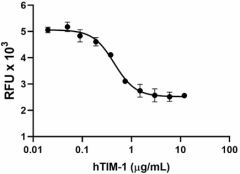- Regulatory Status
- RUO
- Other Names
- TIM1, KIM-1, HAVCR1, CD365, Hepatitis A Virus Cellular Receptor 1, Kidney Injury Molecule 1, T-Cell Membrane Protein 1

-

Recombinant human TIM-1 inhibits the proliferation of anti CD3-activated T cells. The ED50 for this effect is 0.2 - 1.0 µg/mL. -

Stability Testing for Recombinant Human TIM-1. Recombinant human TIM-1 was aliquoted in PBS, pH 7 at 0.2 mg/mL. One aliquot was frozen and thawed four times (4x Freeze/Thaw) and compared to the control that was kept at 4°C (Control). The samples were tested for their ability to inhibit the proliferation of human CD3-activated T cells. The ED50 for this effect is 0.2 - 1.0 µg/mL.
| Cat # | Size | Price | Quantity Check Availability | ||
|---|---|---|---|---|---|
| 720004 | 25 µg | $206.00 | |||
| 720006 | 100 µg | $382.00 | |||
The TIM (T-cell/transmembrane, mucin and immunoglobulin domain) proteins are type I membrane-attached proteins. Three TIM members have been described in humans (TIM-1, TIM-3, and TIM-4) and four in mouse (TIM-1 to TIM-4). The family possesses four domains, the N-terminal Ig variable (IgV) domain, the glycosylated mucin domain, the transmembrane, and the intracellular domain. The TIM proteins bind phosphatidylserine that is exposed on the membrane of apoptotic cells. The binding of phosphatidylserine is through a pocket present in the IgV domain, a metal-ion coordination site. Mouse TIM-2 does not bind phosphatidylserine since it lacks the binding pocket. TIM-1 binds to P-selectin (CD62P) and mediates T-cell trafficking and acts as a costimulatory molecule. Human and mouse TIM-1 are able to bind to selectins in cell-free assays, with higher affinity to P-selectin than E-selectin and L-selectin. A contact hypersensitivity model showed that the interaction between P-selectin and TIM-1 plays a role in the migration of activated T cells in the inflamed skin. TIM-1 was initially identified as the hepatitis A virus cellular receptor 1, and it enhances virus infection of epithelial cells through the interaction of the TIM-1 IgV domain and the phosphatidylserine present on the viral envelope. Thus, TIM-1 interacts with hepatitis A, Hepatitis C, Ebola, dengue, Zika, and Japanese encephalitis viruses.
Product Details
- Source
- Human TIM-1, amino acid (Ser21 - Thr288 ) (Accession: # Q96D42), with a C-terminal 6His tag, was expressed in 293E cells.
- Molecular Mass
- The 277 amino acid recombinant protein has a predicted molecular mass of approximately 29.7 kD. The DTT-reduced and non-reduced protein migrates at approximately 70 and 80 kD by SDS-PAGE respectively. The predicted N-terminal amino acid is Ser.
- Purity
- > 95%, as determined by Coomassie stained SDS-PAGE
- Formulation
- 0.22 µm filtered protein solution is in PBS
- Endotoxin Level
- Less than 0.1 EU per µg cytokine as determined by the LAL method
- Concentration
- 10 and 25 µg sizes are bottled at 200 µg/mL. 100 µg size and larger sizes are lot-specific and bottled at the concentration indicated on the vial. To obtain lot-specific concentration and expiration, please enter the lot number in our Certificate of Analysis online tool.
- Storage & Handling
- Unopened vial can be stored between 2°C and 8°C for up to 2 weeks at -20°C for up to six months, or at -70°C or colder until the expiration date. For maximum results, quick spin vial prior to opening. The protein can be aliquoted and stored at -20°C or colder. Stock solutions can also be prepared at 50 - 100 µg/mL in appropriate sterile buffer, carrier protein such as 0.2 - 1% BSA or HSA can be added when preparing the stock solution. Aliquots can be stored between 2°C and 8°C for up to one week and stored at -20°C or colder for up to 3 months. Avoid repeated freeze/thaw cycles.
- Activity
- Recombinant human TIM-1 inhibits the proliferation of anti CD3-activated T cells. The ED50 for this effect is 0.2 - 1.0 µg/mL.
Antigen Details
- Structure
- Monomer
- Distribution
-
T and B subsets, regulatory B cells, natural killer T cells, mast cells, and tubular epithelial cells after kidney injury
- Function
- Mediates T-cell trafficking during inflammation, acts as a costimulatory molecule, mediates the entry of hepatitis A virus to endothelial cells
- Interaction
- Apoptotic cells, endothelial cells, hepatitis A virus, P-selectin (CD62P), E-selectin (CD62E), L-selectin (CD62E), TIM-1
- Ligand/Receptor
- TIM-4, Phosphatidylserine
- Bioactivity
- Recombinant human TIM-1 inhibits the proliferation of anti CD3-activated T cells.
- Cell Type
- B cells, Endothelial cells, Mast cells, Mesenchymal cells, NKT cells, T cells, Th2
- Biology Area
- Adaptive Immunity, Cancer Biomarkers, Costimulatory Molecules, Immuno-Oncology, Immunology
- Molecular Family
- Adhesion Molecules, CD Molecules, Soluble Receptors
- Antigen References
-
- Austrup F, et al. 1997. Nature. 385:81.
- Umetsu SE, et al. 2005. Nat Immunol. 6:447.
- Kobayashi N, et al. 2007. Immunity. 27:927.
- Santiago C, et al. 2007. Immunity. 27:941.
- Moller-Tank S, et al. 2013. J Virol. 87:8327.
- Angiari S, et al. 2014. Immunity. 40:542.
- Dejarnac O, et al. 2018. Cell Rep. 23:1779.
- Brouillette RB, et al. 2018. J Virol. 92(16). pii: e00093-18.
- Brunton B, et al. 2019. PLoS Negl Trop Dis. 13(6): e0006983.
- Gene ID
- 26762 View all products for this Gene ID
- UniProt
- View information about TIM-1 on UniProt.org
